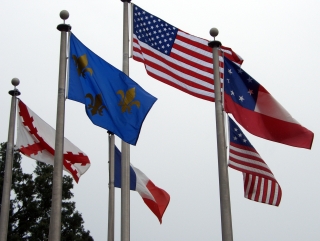Arkansas Post National Memorial
near Gould, Ark.
Visited: August 29, 2005
NPS Site Visited: 240 of 353
NPS Website; Local Website
 WHAT IS IT? WHAT IS IT?
Site of one of France’s earliest permanent New World settlements. For almost 200 years, from 1686 to 1863, the Arkansas Post was an important city but now nothing remains.
BEAUTY (5/10)
The Park is a murky peninsula, surrounded on its wide sides by the bayou, its tip pointing towards the Arkansas River. The sky shines a hazy grayish blue, reflecting the waters’ dark dingy tint. Trees grow in the water. Fields of lily pads float everywhere amidst lime green algae and yellow lotus flowers add an unseen color and a delicate beauty. Snowy Egrets fly above skulking alligators, multiple dragonfly species hover incessantly, mosquitoes swarm and yearling deer race through the ruins of an early Arkansas town.
HISTORIC SIGNIFICANCE (5/10)
It is hard to believe this abandoned bayou backwater could ever have been an important place, but for nearly two centuries, it was the center of European life in the Arkansas region. In 1686, the French built a fort, establishing a trading post and solidifying control of the Arkansas River. The River’s flooding, Chickasaw war parties and British raiders continually forced the fort to be moved.
In 1763, France cedes the region to the Spanish, who soon after establish a presence at Arkansas Post. British soldiers attack the Fort in 1783, during the American Revolution, because Spain has sided with the colonists. France regains the territory in 1800 and sells it to Thomas Jefferson as a part of the Louisiana Purchase. Arkansas Post becomes capital of the Arkansas Territory in 1819 and the Arkansas Gazette (still the State’s major newspaper) begins publication.
 In 1821, Little Rock becomes the capital, the paper moves and the population shrinks from 1830 to only 114. The town is all but dead. The penultimate nail comes in January 1863, during the Civil War, when Union gunboats destroy the Site’s newly built Fort and mercilessly shell the town. Nothing remains. Nature deals the final blow through erosion and the changing course of the Arkansas River. All that remains are alligators, deer, dragonflies, wild turkeys and lotus flowers. In 1821, Little Rock becomes the capital, the paper moves and the population shrinks from 1830 to only 114. The town is all but dead. The penultimate nail comes in January 1863, during the Civil War, when Union gunboats destroy the Site’s newly built Fort and mercilessly shell the town. Nothing remains. Nature deals the final blow through erosion and the changing course of the Arkansas River. All that remains are alligators, deer, dragonflies, wild turkeys and lotus flowers.
CROWDS (6/10)
Just us. We wish we could have spotted some alligators. Maybe if the sky had not been overcast.
EASE OF USE/ACCESS (1/5)
The N MEM is located in the bayou country of southeastern Arkansas, about 60 miles from Pine Bluff and 100 miles from Little Rock.
From Pine Bluff, take U.S. Route 65 southeast until the town of Gould. Wind your way through the back streets of this tiny town along Arkansas Route 212. Once you hit U.S. Rte. 165, turn north (left). In about 5 miles, turn east (right) onto Arkansas Rte. 169. Rte. 169 will lead you through the bayou and to the Park.
If you would prefer to stay on larger roads, continue on 65, past Gould, and to Dumas. From Dumas, take U.S. Rte. 165 for 15 miles until Ark. Rte. 169. Turn right and you will soon be there.
 CONCESSIONS/ BOOKSTORE (4/5) CONCESSIONS/ BOOKSTORE (4/5)
The bookstore has a sparse, but well thought out and interesting selection of merchandise for sale. Jaw Harps, reprints of the two Harper’s Weekly’s that mention the Arkansas Post Civil War battle, reprints of the first issue of the Arkansas Gazette, a cute canned Alligator (stuffed animal in a can, not a meal) and ceramic mugs stamped with the fleur de lis. Cool books include an Arkansas traveler’s 1819 journal, a book on the Indian gun trade, Alan Taylor’s American Colonies and a history of the Arkansas Post written by a Park Service employee.
COSTS (4/5)
The Site is free.
RANGER/GUIDE TO TOURIST RATIO (4/5)
One kind Ranger looked happy to see us; it was a dreary, rainy midweek day and few people were venturing to this bayou ghost town.
TOURS/CLASSES (5/10)
There are a few neat displays in the Museum and the film, while superficial and hokey, is watch-able. The Park holds no interesting secrets and no spellbinding historical revelations. The Site does an able job with its limited material. The Site provides a terrific bird checklist that even lists the specific areas of the Park to look for each bird.
FUN (3/10)
We would have had more fun of there were alligators. We cut our pleasant, but humid, walk around the Post Bayou Nature Trail short because the rain started to come down in droves. The thick trees were not going to provide a sturdy canopy for long. The old townsite was anticlimactic, consisting of only one or two ruins. The climate, ruins, scenery and colonial history reminded us of Georgia’s Fort Frederica NM. We did not have much fun there, either.
 WOULD WE RECOMMEND? (3/10) WOULD WE RECOMMEND? (3/10)
Only if you have a thing for French colonial history. We have heard good things about the newly opened White River National Wildlife Refuge Visitor Center located about 30 miles to the north in St. Charles. The White River NWR is close to the Cache River, the place where some ornithologists believe they found the ivory-billed woodpecker, an elusive bird species thought to have gone extinct. We had our binoculars on and ears open at Arkansas Post but saw and heard nothing.
TOTAL 40/80
|